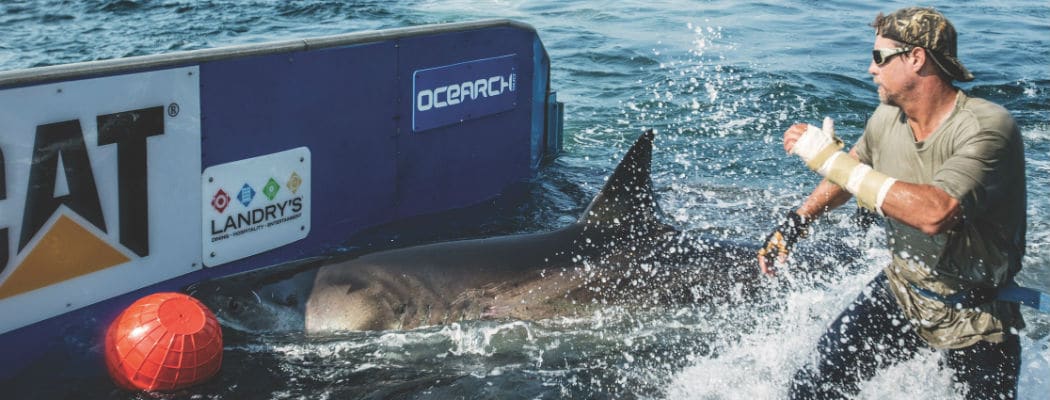How Chris Fischer of OCEARCH is on a mission to save the future of the ocean by protecting its most ferocious predators.
 According to Chris Fischer, at least 200,000 sharks are killed every day. For some skittish swimmers, this information might come as something of a relief, but for Chris Fischer and others who understand the critical role these apex predators play in the ocean, the extreme decline in the global shark population is truly horrifying. “If we lose our sharks, there won’t be any fish,” Fischer explains. “They’re the balance keepers, the lions of the ocean. If your lions are thriving, your system is in balance, because they’re the top of the food chain.” When Fischer realized that “we were losing close to 100 million sharks per year for a bowl of soup” eight years ago, he set out on a bold mission to rescue these lions of the ocean, starting with the king of the pride: the great white.
According to Chris Fischer, at least 200,000 sharks are killed every day. For some skittish swimmers, this information might come as something of a relief, but for Chris Fischer and others who understand the critical role these apex predators play in the ocean, the extreme decline in the global shark population is truly horrifying. “If we lose our sharks, there won’t be any fish,” Fischer explains. “They’re the balance keepers, the lions of the ocean. If your lions are thriving, your system is in balance, because they’re the top of the food chain.” When Fischer realized that “we were losing close to 100 million sharks per year for a bowl of soup” eight years ago, he set out on a bold mission to rescue these lions of the ocean, starting with the king of the pride: the great white.
“Man, I just remember fear,” Fischer says of the first time he climbed into the water to place a tag on a mature white shark. “The fear of the unknown. Everyone said it was impossible.” Aboard his 126-foot, 600 ton M/V OCEARCH research vessel, which was converted from an old Alaskan crabber, Fischer and his team of scientists and shark specialists have developed a revolutionary method of tagging and tracking great white sharks. Equipped with a custom lift that can haul up to 75,000 pounds, Fischer hooks great whites, lures them on to the lift and then raises them out of the water, allowing a team of scientists to descend upon the hulking predators to run tests and secure a tracking device on their dorsal fins. “The biggest issues we have are just getting slapped by a tail and getting your skin scraped off and getting an infection,” Fischer explains. “I mean the single biggest challenge for me has just been trying to survive and finance it.”
Since tagging his first shark in 2007, Fischer’s nonprofit research organization, OCEARCH, has become a global phenomenon, giving way to an award-winning television series, tens of thousands of magazine and newspaper articles, and over three billion media impressions around the world. “We had over 7 billion people follow our work last year… that’s billion with a B,” says Fischer, who was inducted into the exclusive Explorers Club in 2009, where his name will forever reside along the likes of Neil Armstrong and Sir Edmund Hillary. At the age of forty-six, Fischer has led twenty-two expeditions. Cousteau led twenty-seven.
 “We’re working to try to shift the tone of the conversation around sharks, shift it from fear to appreciation and fascination,” Fischer says. “I do believe we are going to win the shark war within the decade or so. The awareness level is driving down demand in China for shark fin soup, which is the primary issue.”
“We’re working to try to shift the tone of the conversation around sharks, shift it from fear to appreciation and fascination,” Fischer says. “I do believe we are going to win the shark war within the decade or so. The awareness level is driving down demand in China for shark fin soup, which is the primary issue.”
Scientifically speaking, OCEARCH is closing what Fischer describes as “fundamental data gaps.” Fundamental data gaps concern the migratory habits of the great whites as it relates to reproduction. In order to protect the future of the species, Fischer needs to protect where sharks mate and where they give birth, information that has remained largely a mystery to this point. Now tracking 129 sharks around the world, Fischer and his team are starting to piece together a surprising picture, a key component of which takes place right in our waters.
“Nantucket is a crucial area for the North Atlantic white shark,” he explains. “It appears that that area and the Monomoy peninsula are connected, and there’s a tremendous amount of foraging opportunity there as the seals recover.” Fischer believes that the waters around Nantucket may very well be a place where white sharks mate. His hunch is quite literally pinned on the dorsal fin of a 4,000-pound, sixteen-plus-foot great white named Mary Lee, who OCEARCH tagged off Monomoy peninsula in September of 2012. Since they began tracking the mature female, Mary Lee has returned to the waters south of Nantucket around the same time each fall. “If she returns this fall, she’ll complete the first full three-year migratory loop of a mature female,” he explains, “and then within that loop is the mating site, a birthing site, and then the full range which we need to protect her.”
 Even if Mary Lee does return this fall, Fischer plans on leading another expedition in the waters around Nantucket to tag mature male great whites. He needs a sample size of over fifteen “good pinging sharks” to provide enough data to confirm migratory patterns, mating and birthing sites, and nurseries. This is easier said than done. Fischer explains that tagging a shark in the North Atlantic is much harder than elsewhere in the world. “We’re dealing with descendants of the most nervous, elusive white sharks that survived all that pressure [of whaling and long lining,]” he says. “On the Atlantic seaboard these are really wild sharks. They have no cage diving component to their lives. They’re not conditioned to come to a boat for food or anything like that. So they’re super duper nervous, which I think is good for all of us.”
Even if Mary Lee does return this fall, Fischer plans on leading another expedition in the waters around Nantucket to tag mature male great whites. He needs a sample size of over fifteen “good pinging sharks” to provide enough data to confirm migratory patterns, mating and birthing sites, and nurseries. This is easier said than done. Fischer explains that tagging a shark in the North Atlantic is much harder than elsewhere in the world. “We’re dealing with descendants of the most nervous, elusive white sharks that survived all that pressure [of whaling and long lining,]” he says. “On the Atlantic seaboard these are really wild sharks. They have no cage diving component to their lives. They’re not conditioned to come to a boat for food or anything like that. So they’re super duper nervous, which I think is good for all of us.”
Fischer insists that these sharks have been swimming among us for some time now and there is nothing to indicate that shark attacks will increase in the waters around Nantucket as more great whites begin targeting our growing grey seal population. “I think the issues are really only positive,” he claims. “You’re going to see a more robust ocean, a more balanced ocean, more fish, a balance in the seals, and the likelihood of an interaction with these sharks is so statistically low that I don’t think you’re really going to see anything change.”
But Fischer doesn’t want people to just take his word for it. All the data collected by scientists aboard OCEARCH is made completely available to anyone interested. Enthusiasts can log on to Ocearch.org or download the OCEARCH app and track their favorite sharks. “Mary Lee has 80,000 people following her Twitter account,” Fischer says matter-of-factly. There’s even a STEM-based curriculum designed for third through eighth graders around the OCEARCH’s shark tracker online.
 Despite this wealth of information, media hype, and some big name sponsors, Fischer says OCEARCH is struggling to stay afloat. “We’re making a billionaire’s impact on a workingman’s wage by being scrappy and entrepreneurial,” he explains. “It’s time for the big boys to come in and really amplify and multiply this so that we can create a plan for the future of the ocean and apex predators all the way down.” Fischer says an $80 million endowment would keep OCEARCH sailing smoothly indefinitely. For that, he’s looking to Nantucket, hoping to find someone interested in leaving a lasting legacy on the ocean. “It’s just such a special place that you all have up there with a special group of people who have the capacity to affect the future of the planet,” he says. “It’s interesting that this puzzle is really centralized around a group of people in a place that actually has the capacity to fix the problem at scale.”
Despite this wealth of information, media hype, and some big name sponsors, Fischer says OCEARCH is struggling to stay afloat. “We’re making a billionaire’s impact on a workingman’s wage by being scrappy and entrepreneurial,” he explains. “It’s time for the big boys to come in and really amplify and multiply this so that we can create a plan for the future of the ocean and apex predators all the way down.” Fischer says an $80 million endowment would keep OCEARCH sailing smoothly indefinitely. For that, he’s looking to Nantucket, hoping to find someone interested in leaving a lasting legacy on the ocean. “It’s just such a special place that you all have up there with a special group of people who have the capacity to affect the future of the planet,” he says. “It’s interesting that this puzzle is really centralized around a group of people in a place that actually has the capacity to fix the problem at scale.”






